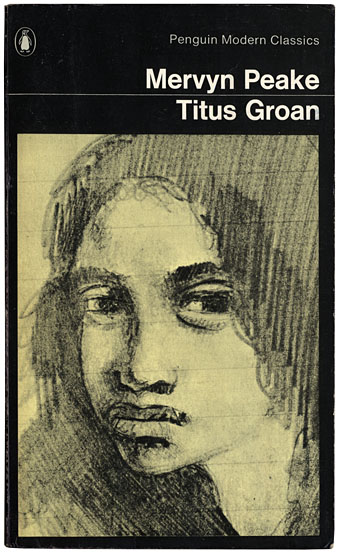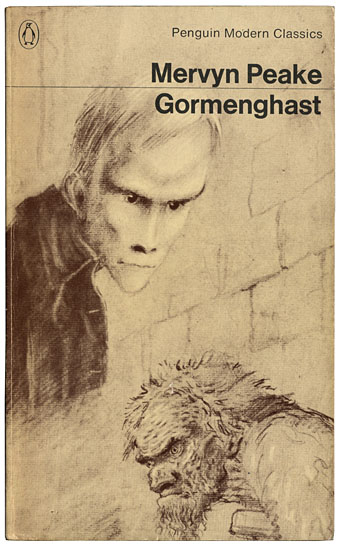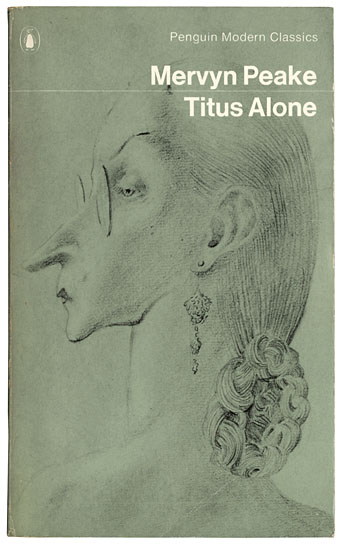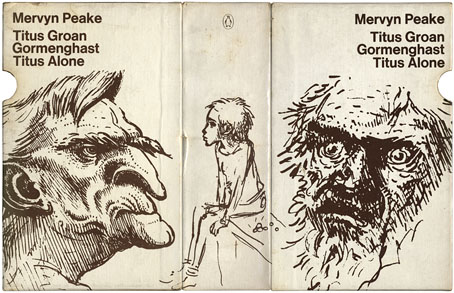Bellgrove, young Titus and Barquentine by Mervyn Peake. Case designed by Robert Hollingsworth.
I’d thought about posting the covers of my boxed set of Gormenghast paperbacks a couple of years back when there was a flurry of blogospheric attention being given to Penguin cover designs…thought about it then never got round to it. The reason for doing so now is twofold: firstly I’ve been re-reading the books, and secondly some Gormenghast-related news emerged this week which gives this post an additional relevance.

Fuchsia by Mervyn Peake.
The set of Peake paperbacks which Penguin published in 1968 (and their subsequent reprints) were the first editions of Peake’s trilogy which I encountered so I can’t help but regard them as the ones, the only copies I could countenance reading. That may change, however (see below). I’ve no idea how scarce the boxed edition is but the books are reprintings from 1970 so I presume Penguin put out a boxed gift set to make the most of Peake’s posthumous success. I always liked the presentation which is the standard Penguin Modern Classics format of the period, it leaves to you how much you want to regard the books as works of fantasy or simply novels of a rather grotesque and highly imaginative reality. Titus Groan‘s sketch of a glowering and thoroughly unglamorous Fuchsia was a daring choice for a cover intended to lure a newer, younger audience to Peake’s work. The drawing says a great deal about the author’s unsentimental attitude towards his creations; compared to the florid and often delicate covers of the fantasy books being published by Ballantine in the late Sixties (a series which included the Gormenghast trilogy), it seems shockingly unpleasant.

Steerpike and Barquentine by Mervyn Peake.
These covers and Peake’s other sketches of his characters fascinated me for years, they’re almost unique in the way they allow us to peer directly into the writer’s imagination. My only quibble is that they didn’t use one of the other Steerpike drawings for the second book, although another glowering face might have been too much. It’s this latter work I always think of when reading a description of Steerpike, and it’s undoubtedly the one Jon Savage had in mind when he very smartly compared Johnny Rotten of the Sex Pistols to Peake’s villain in a newspaper article, probably the only time Peake and the punk movement have been connected in any context.

Irma Prunesquallor by Mervyn Peake.
Other writers—Lewis Carroll and Tolkien, for example—have provided sketches of scenes or characters from their fiction but their draughtsmanship is never accomplished enough to do full justice to their literary imagination. With Peake you know that you’re seeing the characters exactly as he imagined them and it’s for that reason that I’m excited by news of a new edition of Gormenghast which will feature more of his drawings. In the same announcement there’s news of a 2011 publication of Titus Awakes, an unpublished sequel to Peake’s trilogy by his wife, Maeve Gilmore, who was an artist when the pair first met, and later the writer of a memoir of her husband, and a book for children, Captain Eustace and the Magic Room.
And while we’re on the subject, when I was in Manchester’s City Art Gallery recently, I noticed that Peake’s large painting The Glassblower (1944), which is part of the gallery’s permanent collection, can now be purchased on a range of cards and prints.
Update: Titus Groan rises again! Sebastian Peake on Titus Awakes.
• Mervynpeake.org
• Peake Studies
• An excellence of Peake | An essay by Michael Moorcock
Elsewhere on { feuilleton }
• The illustrators archive
• The book covers archive
Previously on { feuilleton }
• Joseph Cavalieri’s stained glass
• Mervyn Peake at Maison d’Ailleurs
• Peake’s Pan
• Buccaneers #1
• Pauline Baynes, 1922–2008
• Mervyn Peake in Lilliput
• The Illustrators of Alice


Hi there, John!
You can see the Bob Pepper covers to Peake’s books on the Peake Studies site too, reproduced in pairs here and here so that you can see how they form a garish triptych.
Cheers
Peter
I had the chance to interview Michael Moorcock some years ago and he mentioned that he was writing a memoir of the time he spent with Peake and his wife. He said he ‘d try to finish it by early 2007, but I suppose it’s not done yet (unless it’s published already and I ‘ve missed it). A brief google search unearthed a small excerpt that Moorcock offered to Cory Doctorow. It’s posted here:
http://www.boingboing.net/2008/07/26/michael-moorcocks-bi.html
I have to re- read Gormenghast again. It’s been ages since the last time.
Thanks, Peter. Much as I like Bob Pepper’s work I feel he made those covers far too medieval in appearance, they jar with the reproductions of Peake’s character sketches inside the books.
Dimitris: As far as I’m aware that memoir has been sidelined for the moment by other work. However, the opening chapter is included in Into the Media Web, a 720-page collection of Moorcock’s non-fiction which I designed recently for Savoy Books and which should be published later this year. That collection includes several other pieces about Peake and the Gormenghast books.
I’m intrigued about the 4th book.
Pleased also that a more extensively illustrated edition is to be published of the ‘trilogy’, that’ll be replacing my copy with just a few of the sketches in.
The 1960s Penguin Editions of the trilogy were my first introduction to Peake as well and I still have all three.
I reread them last year – as always, mindblowing prose.
My goodness. Its been 38 years since I read this trilogy. What memories this brings back. I had the Ballentine covers. I loved them. I loved Fushia’s flaming red hair against the gothic towers.
It is wonderful to see these illustrations again, Steerpike, Irma Prunesquallor. Fushia exploring the castle is an image I have remembered many times. Going to have to look for these again at half-price books, and get the 60’s version. Good stuff John. Betty.